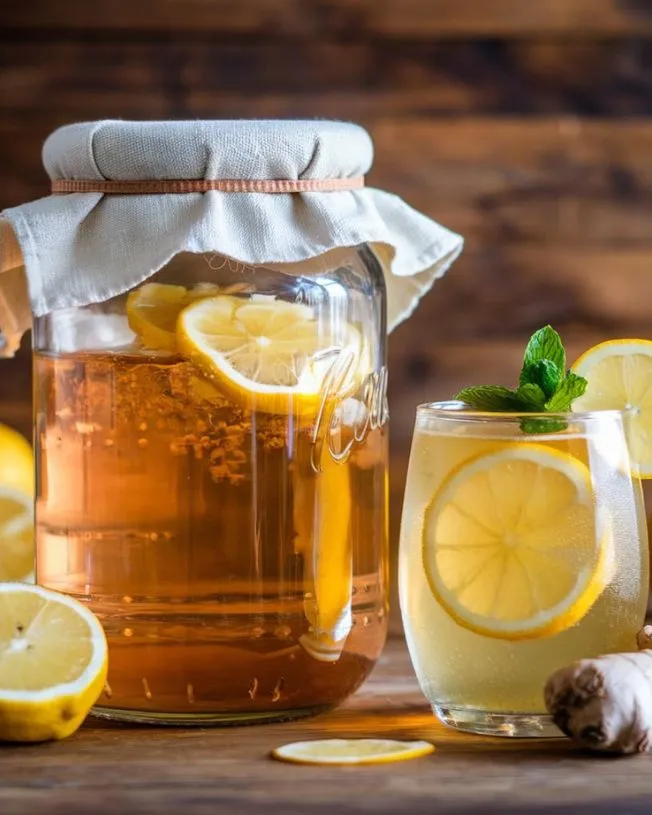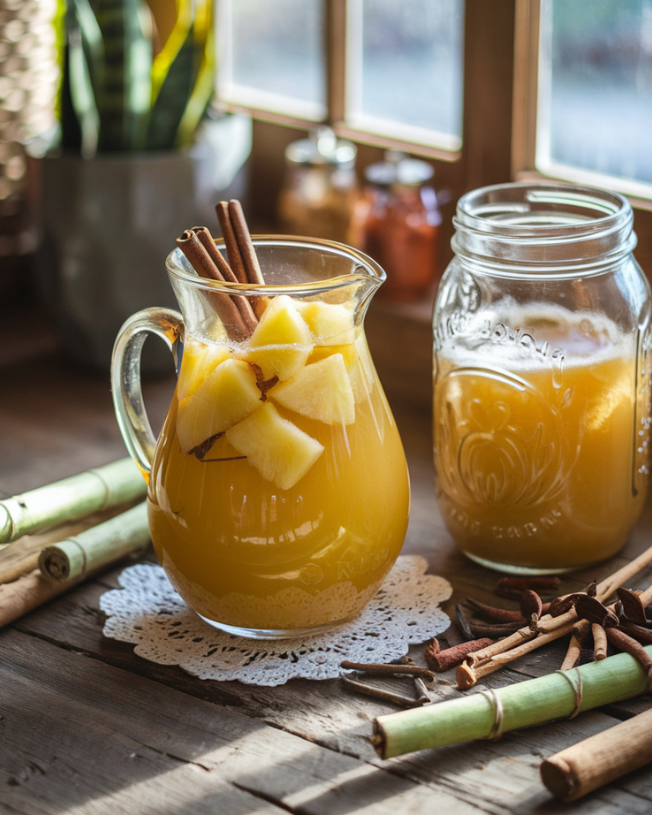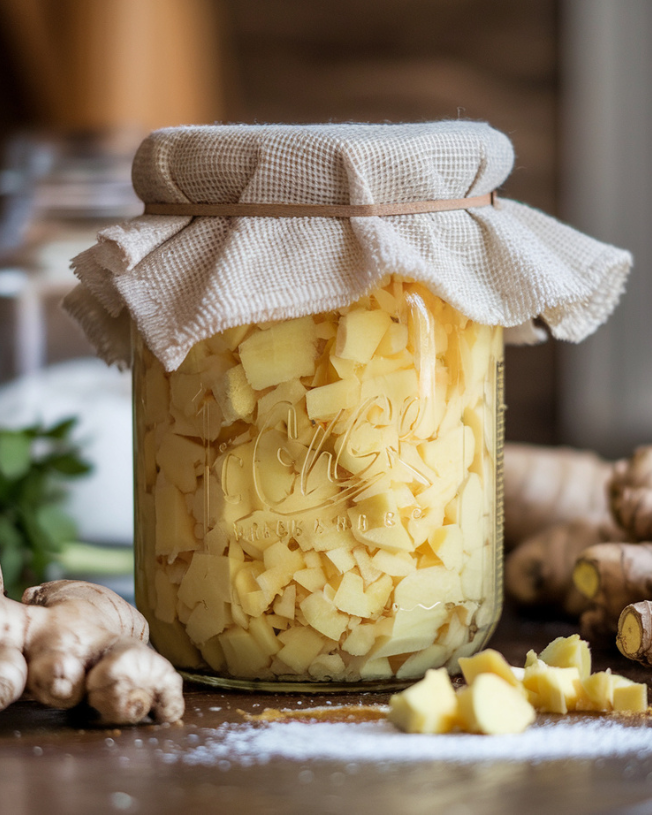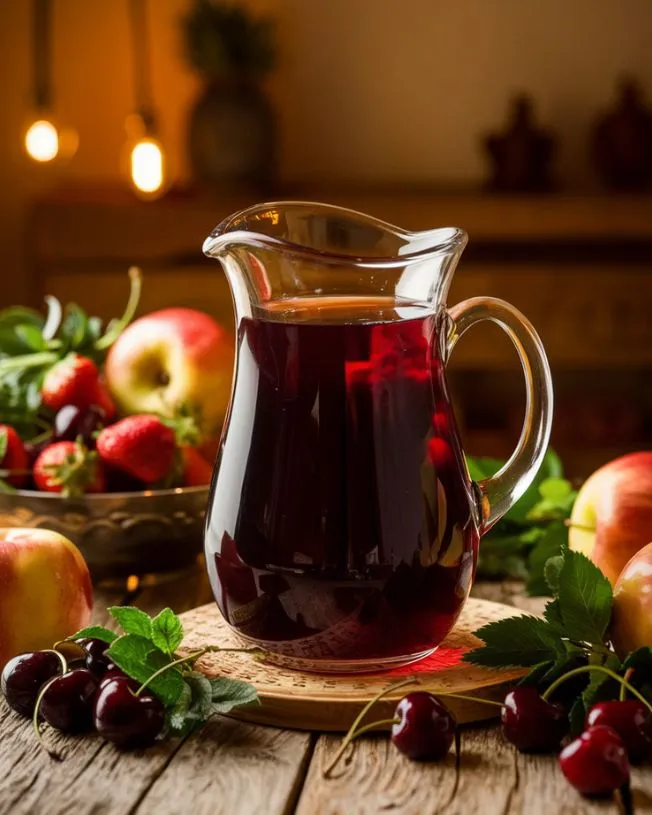Ginger kombucha is a uniquely refreshing drink with a tangy kick that’s captured the interest of health-conscious individuals around the world. This fizzy, probiotic-rich drink not only quenches thirst but also offers potential health benefits. Whether you’re a kombucha enthusiast or new to fermenting, this guide will teach you how to make ginger kombucha at home, exploring its health benefits, common questions, and serving tips. Adding ginger to kombucha gives it a delightful, spicy warmth that perfectly complements its natural tartness.
What is Ginger Kombucha?
Ginger kombucha is essentially regular kombucha — a fermented tea drink — infused with fresh ginger during a second fermentation stage. Kombucha itself is made by fermenting tea with a SCOBY (Symbiotic Culture of Bacteria and Yeast), which transforms sweetened tea into a naturally fizzy, probiotic-rich drink. When ginger is added, it brings a distinctive warmth and zest to the kombucha, enhancing both its flavor and health benefits.
Why Drink Ginger Kombucha?
The popularity of this drink stems from its potential benefits. With probiotics from the kombucha and anti-inflammatory properties from ginger, this drink may support gut health, boost immunity, and even help with digestion. The following are some of the main benefits associated with ginger kombucha:
- Digestive Health: Kombucha’s probiotics support healthy digestion, while ginger is known for aiding nausea relief and easing digestive discomfort.
- Anti-Inflammatory Benefits: Ginger is naturally anti-inflammatory, which may help reduce muscle soreness and joint pain, particularly for those with active lifestyles.
- Immune Support: Ginger has antioxidants that promote immune health. Together with kombucha’s probiotics, this drink offers a wellness boost.
- Energy Boost: Kombucha contains a small amount of caffeine from tea and a natural fermentation process that can provide gentle energy.
- Nutrient Absorption: A healthy gut aids in nutrient absorption. Drinking kombucha may support gut health, maximizing nutrient uptake.
Ingredients for Ginger Kombucha
Creating this kombucha at home requires only a few basic ingredients, making it an accessible project for beginners and experts alike.
- SCOBY: This is essential for the fermentation process. You can find SCOBYs online or from other kombucha brewers.
- Tea: Black or green tea provides nutrients for the SCOBY.
- Sugar: The sugar feeds the SCOBY and initiates fermentation. Most sugar will be broken down during the process, leaving minimal sweetness.
- Fresh Ginger: This is added during the second fermentation, providing a spicy kick and health benefits.
- Filtered Water: Use non-chlorinated water to avoid disrupting fermentation.
How to Make Ginger Kombucha: Step-by-Step Guide
Making this recipe involves two main steps: creating the base kombucha and adding ginger for the second fermentation. Here’s a detailed guide:
Step 1: Brew the Base Kombucha
Prepare the Sweet Tea
Boil 8 cups of water and dissolve 1 cup of sugar into the water, stirring until fully dissolved.Steep the Tea
Add 4-5 black or green tea bags to the sweetened water and steep until it reaches room temperature. Removing the tea bags before the water cools prevents bitterness.Combine with the SCOBY
Once the tea is cool, pour it into a clean glass jar and place the SCOBY on top.Place a breathable cloth or paper towel over the jar, and secure it with a rubber band.Ferment for 7-10 Days
Store the jar in a dark, room-temperature area and let it ferment for 7-10 days. Taste-test periodically until you find your desired tanginess; a longer fermentation produces a more sour drink.
Step 2: Add Ginger for Secondary Fermentation
Prepare the Ginger
Peel and slice or grate about 1-2 inches of fresh ginger root.Bottle the Kombucha
Remove the SCOBY and pour the kombucha into individual bottles, leaving room at the top.Add the Ginger
Place the ginger slices or grated ginger in each bottle to infuse during the second fermentation.Seal and Ferment Again
Tightly seal the bottles and let them sit at room temperature for another 2-5 days. This second fermentation increases carbonation, giving the kombucha its natural fizz.Refrigerate and Enjoy
Once the kombucha reaches the desired level of fizz, store the bottles in the refrigerator to slow fermentation. Your ginger kombucha is ready to serve!
Tips for a Successful Ginger Kombucha Brew
Kombucha brewing is both an art and a science. Here are some tips to make sure your ginger kombucha turns out just right:
Adjust Ginger to Taste
Start with a smaller amount of ginger and add more if you prefer a stronger flavor.Handle Bottles with Care
Carbonation builds during the second fermentation, so open bottles cautiously to avoid spills.Use Fresh Ingredients
Fresh ginger will give you the best flavor and health benefits.Add Other Ingredients
Feel free to add lemon, herbs, or a splash of juice to create more complex flavors.
FAQs
Can I Use Green Tea for Kombucha?
Yes! Green tea produces a lighter flavor that pairs well with ginger.
How Long Does Ginger Kombucha Last?
Refrigerated ginger kombucha can last several weeks, though flavor may evolve.
Is Ginger Kombucha Alcoholic?
Kombucha has trace alcohol due to fermentation (typically less than 0.5%), making it generally non-alcoholic.
Do I Need a SCOBY?
Yes, a SCOBY is essential for traditional kombucha brewing. Without it, the drink won’t ferment properly.
Why Does My Kombucha Taste Sour?
Over-fermentation leads to sourness. Reduce fermentation time or add juice for sweetness if desired.
Serving Suggestions
this fermented drink is versatile and enjoyable on its own, but here are some creative ways to serve it:
Over Ice
Pour chilled ginger kombucha over ice for an extra refreshing drink.In Smoothies
Add a dash to your favorite smoothie for an extra boost of probiotics.Mocktails and Cocktails
Mix kombucha with fruit juice or use it as a cocktail mixer for added complexity.Garnished with Fresh Herbs
Add mint or basil for a fragrant garnish that enhances the kombucha experience.
Troubleshooting Common Kombucha Issues
Brewing kombucha comes with occasional challenges. Here are solutions to common problems:
No Fizz
If your kombucha lacks fizz, try extending the second fermentation or ensuring bottles are tightly sealed.Unusual Smell or Mold
A sour smell is normal, but mold (which is rare) appears fuzzy and blue, green, or black. If mold develops, discard the batch and start fresh.Overly Sweet or Flat Taste
If your kombucha is too sweet, ferment it longer. For flat kombucha, ensure proper bottling for the second fermentation.
Final Thoughts on Ginger Kombucha
Making it is a fun and rewarding project that offers a host of potential health benefits. With its delightful balance of tartness and spice, ginger kombucha is a drink that stands out, perfect for those seeking a flavorful way to improve gut health and enjoy a fizzy beverage without added sugars. Plus, the simple process allows you to customize each batch to your taste, experimenting with different flavorings, teas, and fermenting times. With this guide, you’re well on your way to becoming a confident kombucha brewer.
Whether you’re sipping it solo, adding it to a smoothie, or mixing it into a mocktail, ginger kombucha is a refreshing way to bring some healthful probiotics into your routine. So, get your SCOBY, grab some fresh ginger, and start brewing — your digestive system (and taste buds) will thank you!









